
(if you’re not sure which type of interface your computer has, check the appendix for your computer).
So when do you use graphics and when do you use download characters? Practically anything you can do with graphics you can do with download characters, and vice versa. A clever pro- grammer could actually plot a mathematical curve using down- load characters or use strings of graphics data as
•If the graphic image to be printed is wider than 11 dots or higher than 8 dots
•If an image is to be printed just one time, as opposed to a frequently used “text” character
•If you want higher resolution
USING THE DOT GRAPHICS COMMANDS
The command to print normal density (60 dots per inch hor- izontal; 72 dots per inch vertical) dot graphics uses this format:
<ESC> “K” nl n2 ml m2 .....
Just like many of the other codes you have learned, the com- mand starts with an escape sequence ( < ESC > “K” in this case). But unlike
graphics data bytes following the command. That’s where nl and - n2 come in; they are used to tell SR- lo/15 how many bytes of graphics data to expect.
nSpecifying the number of columns of dots
To figure the values of nl and n2, you’ll need to figure out how wide your graphic image will be (remember that there are 60 columns of dots per inch in normal density). Then comes the fun part: converting one number (the number of columns of dots) into two! Why is it necessary to use two numbers to tell
104
